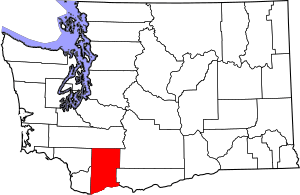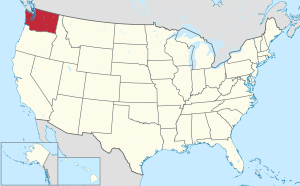Skamania County, Washington facts for kids
Quick facts for kids
Skamania County
|
|
|---|---|

Skamania County panorama
|
|

Location within the U.S. state of Washington
|
|
 Washington's location within the U.S. |
|
| Country | |
| State | |
| Founded | March 9, 1854 |
| Seat | Stevenson |
| Largest city | Carson |
| Area | |
| • Total | 1,683 sq mi (4,360 km2) |
| • Land | 1,656 sq mi (4,290 km2) |
| • Water | 28 sq mi (70 km2) 1.7% |
| Population
(2020)
|
|
| • Total | 12,036 |
| • Estimate
(2023)
|
12,640 |
| • Density | 7.15/sq mi (2.76/km2) |
| Time zone | UTC−8 (Pacific) |
| • Summer (DST) | UTC−7 (PDT) |
| Congressional district | 3rd |
Skamania County (/skəˈmeɪniə/ SKƏ-may-NEE-ə) is a county located in the U.S. state of Washington. As of the 2020 census, the population was 12,036. The county seat and largest incorporated city is Stevenson, although the Carson River Valley CDP is more populous. Skamania County is included in the Portland-Vancouver-Hillsboro, OR-WA Metropolitan Statistical Area.
History
Etymology
The county was founded in 1854 and derives its name from the Cascades Chinook word sk'mániak, meaning 'swift waters'.
County beginnings
The area delineated by the future Washington state boundary began to be colonized at the start of the nineteenth century, both by Americans and British subjects. However, the majority of British exploration and interest in the land was due to the fur trade, whereas American settlers were principally seeking land for agriculture and cattle raising. The Treaty of 1818 provided for the region to be an Anglo-American condominium. During this period, the future Washington Territory was divided into two administrative zones: Clarke County (now Clark County) and Lewis County (made official in 1845).
The condominium was unwieldy and led to continual argument, and occasional conflict. The status of the Washington area was settled in 1846, when the Oregon Treaty ceded the land south of North latitude 49 degrees to American control.
On March 9, 1854, Skamania County was split from the original Clarke County and stretched east to the Rocky Mountains in present-day Montana. Walla Walla County was split from the portions of Skamania County east of the Deschutes River on April 24. The county lost its eastern edge during the creation of Klickitat County in 1861.
The territorial legislature dissolved Skamania County and divided its land between Clarke and Klickitat counties in January 1865 during a taxing dispute with the Oregon Steam Navigation Company. The dissolution was repealed in 1867 after intervention from the U.S. Congress. After that, Skamania County retained its shape, including through the period after Washington became the 42nd state of the Union in 1889. Fort Cascades, built to protect the Columbia River, served as an early county seat, but the county seat has been in Stevenson since 1893.
20th century to present day
Skamania County is also known for enacting what has been described as the "Bigfoot Ordinance", passed by the Board of County Commissioners at its meeting of April 1, 1969, and published twice in the Skamania County Pioneer, the newspaper of highest circulation in the county, as required by law. The ordinance forbids the slaying of any "nocturnal primate mammal variously described as an ape-like creature or a sub-species of Homo sapiens ... generally and commonly known as a 'Sasquatch', 'Yeti', 'Bigfoot', or 'Giant Hairy ape'", subject to a maximum penalty of a $10,000 fine and five years imprisonment. Although its passage coincided with April Fool's Day, Ordinance 69-01 was real, was amended in 1984, and has not been repealed. Its purposes included protection of residents and visitors from in the county from a very real concern, "an influx of scientific investigators as well as casual hunters, many armed with lethal weapons", who had been attracted to the area by reported sightings of a creature.
Mt. St. Helens, which is located in Skamania County, erupted in 1980.
Geography
According to the United States Census Bureau, the county has a total area of 1,684 square miles (4,360 km2), of which 1,656 square miles (4,290 km2) is land and 28 square miles (73 km2), or 1.7%, is water. 90% of Skamania is forested and 80% is a part of Gifford Pinchot National Forest. The highest elevation in the county is 8,920 feet (2,720 m), on the slopes of Mount Adams, although prior to its eruption, Mount Saint Helens was the highest point at 9,677 feet (2,950 m).
Geographic features
Major highways
Adjacent counties
- Lewis County - north
- Yakima County - northeast
- Klickitat County - east
- Hood River County, Oregon - south
- Multnomah County, Oregon - southwest
- Clark County - west
- Cowlitz County - west
Demographics
| Historical population | |||
|---|---|---|---|
| Census | Pop. | %± | |
| 1860 | 173 | — | |
| 1870 | 133 | −23.1% | |
| 1880 | 809 | 508.3% | |
| 1890 | 774 | −4.3% | |
| 1900 | 1,688 | 118.1% | |
| 1910 | 2,887 | 71.0% | |
| 1920 | 2,357 | −18.4% | |
| 1930 | 2,891 | 22.7% | |
| 1940 | 4,633 | 60.3% | |
| 1950 | 4,788 | 3.3% | |
| 1960 | 5,207 | 8.8% | |
| 1970 | 5,845 | 12.3% | |
| 1980 | 7,919 | 35.5% | |
| 1990 | 8,289 | 4.7% | |
| 2000 | 9,872 | 19.1% | |
| 2010 | 11,066 | 12.1% | |
| 2020 | 12,036 | 8.8% | |
| 2023 (est.) | 12,640 | 14.2% | |
| U.S. Decennial Census 1790–1960 1900–1990 1990–2000 2010–2020 |
|||
2020 census
As of the 2020 census, there were 12,036 people, 4,748 households, and 3,199 families residing in the county. The population density was 7.3 inhabitants per square mile (2.8/km2). There were 5,796 housing units at an average density of 3.5 inhabitants per square mile (1.4/km2). The racial makeup of the county was 85.6% White, 0.6% African American, 1.6% Native American, 1.0% Asian, 0.3% Pacific Islander, 2.4% from some other races and 8.5% from two or more races. Hispanic or Latino people of any race were 6.4% of the population. 16.7% of residents were under the age of 18, 3.7% were under 5 years of age, and 25.8% were 65 and older.
2010 census
As of the 2010 census, there were 11,066 people, 4,522 households, and 3,072 families living in the county. The population density was 6.7 people per square mile (2.6 people/km2). There were 5,628 housing units at an average density of 3.4 units per square mile (1.3 units/km2). The racial makeup of the county was 92.8% white, 1.6% American Indian, 0.9% Asian, 0.4% black or African American, 0.1% Pacific islander, 1.3% from other races, and 3.0% from two or more races. Those of Hispanic or Latino origin made up 5.0% of the population. In terms of ancestry, 20.6% were German, 15.7% were Irish, 11.0% were English, 6.3% were Norwegian, and 5.0% were American.
Of the 4,522 households, 28.4% had children under the age of 18 living with them, 54.3% were married couples living together, 8.9% had a female householder with no husband present, 32.1% were non-families, and 25.6% of all households were made up of individuals. The average household size was 2.44 and the average family size was 2.92. The median age was 44.0 years.
Recreation
- Skamania County has abundant trails within its borders, including hiking at the Columbia River Gorge and Gifford Pinchot National Forest, which includes the Mount St. Helens National Volcanic Monument. The Pacific Crest Trail passes through Skamania County.
- Fishing in Skamania County allows for the opportunity to catch certain popular species such as rainbow trout, steelhead and bass.
- The Columbia Gorge Museum, in Stevenson, examines the geologic and human past in the Columbia River Gorge.
- The Lewis and Clark Expedition passed through Skamania County, and some of their campsites can be visited.
- Historical markers are located in several areas, such as Fort Cascades and Fort Raines, both built in the 1850s to protect the portage road around the Cascades Rapids.
- Kiteboarding and windsurfing are seasonal sports popular in the Columbia River Gorge.
Parks and other protected areas
County parks
- Prindle Park is a county-maintained park with picnic facilities and a playground.
- Big Cedars Campground is a county-maintained campground with primitive campsites.
- Home Valley Campground is another county-maintained camping area.
State parks
- Beacon Rock State Park offers hiking, camping, rock climbing, and picnicking facilities.
Sites maintained by the US Forest Service
- Sams Walker Day Use Site offers an interpretive trail, access to the Columbia River, and opportunities to view wildlife. Portions of it are typically wheelchair-accessible. However, vegetation growth sometimes prevents people in wheelchairs from using the trails.
- St. Cloud Day Use Site features a short, easy trail through a meadow, picnic area, access to the Columbia River and wildlife viewing opportunities.
National protected areas
- Franz Lake National Wildlife Refuge
- Gifford Pinchot National Forest (part)
- Mount St. Helens National Monument (part)
- Pierce National Wildlife Refuge
- Wind River Arboretum
- Wind River Experimental Forest
Communities
Cities
- North Bonneville
- Stevenson (county seat)
Census-designated place
- Carson
- Carson River Valley (former)
Unincorporated communities
See also
 In Spanish: Condado de Skamania para niños
In Spanish: Condado de Skamania para niños

